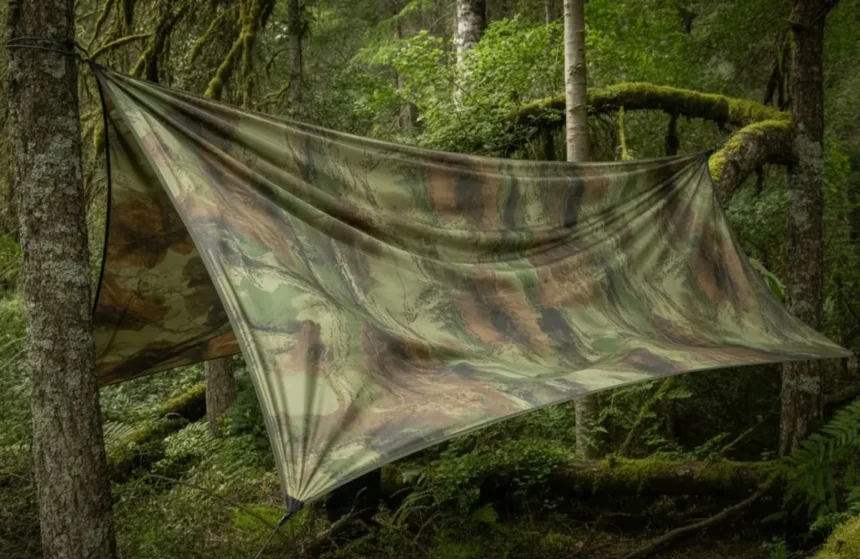What is Tarnplanen?
The term tarnplanen originates from German: ”Tarn” meaning camouflage and ”Planen” meaning tarpaulins or covers. In practical terms, a tarnplanen is a camouflage sheet or tarpaulin designed to blend into its surroundings while also offering protection — whether from rain, sun, wind or visual detection.
These covers were originally developed for military and tactical uses, where concealment is critical. Over time they have found broad applications in outdoor recreation, hunting, photography and even commercial or industrial protection. By combining durability, weather-resistance and camouflage, tarnplanen serves a dual role: protection and stealth.
In short: if you want something that hides and shields — in forests, deserts, urban zones or other terrain — a tarnplanen is exactly the kind of gear you should know about.
Key Features of Tarnplanen
-
Durable, weather-resistant material (e.g., reinforced plastics, polyester, coated nylon)
-
Camouflage pattern matched to terrain (woodland, desert, urban, digital)
-
Waterproof or water-repellent finish to keep out rain and moisture
-
Eyelets or grommets along edges for tie-downs and secure anchoring
-
Multiple tie-out points allowing versatile setup (lean-to, A-frame, shelter)
-
Lightweight enough for portability, yet strong enough for rough environments
-
Multi-purpose: used as groundsheet, overhead cover, concealment net, shelter
These features together define what makes a tarnplanen more than a simple plastic sheet. They are designed for serious use, not just casual covering, and often take into account both functional durability and visual concealment needs.
Primary Materials & Construction
When you dig deeper into what makes a good tarnplanen, the material and construction matter a lot. Many tarnplanen are made from polyethylene (PE), polyvinyl chloride (PVC), polyester or nylon fabrics — often with coatings such as polyurethane (PU) or silicone for waterproofing. The choice of material influences durability (e.g., tear resistance), weight, weather-performance (UV resistance, rain) and packability.
In addition:
-
Edges often reinforced with stronger webbing or extra fabric to avoid ripping under tension.
-
Grommets or eyelets made of metal, spaced around the perimeter so you can tie down securely — crucial in wind or bad weather.
-
Seams sometimes taped or heat-sealed to avoid leakage and increase lifespan.
-
Camouflage pattern printed or woven, ideally matched to environment for visual effectiveness.
For example, a high-end tarnplanen might use ripstop nylon with a PU coating and taped seams. This offers a lightweight package yet high performance. On the flip side, a cheaper model may use thin PE with welded seams but less longevity or durability under heavy use.
Camouflage Patterns & Color Systems
Camouflage is not just decoration; it’s functional. The pattern and colours of a tarnplanen need to match the environment where you’ll use it to maximize concealment. Common pattern systems include:
-
Woodland Camo – greens, browns and blacks, suited for forested areas.
-
Desert/Arid Camo – tans, beige, light browns for open dry terrain.
-
Urban Camo – greys and blacks to blend with concrete, steel, shadows.
-
Digital/Pxielated Camo – small blocks of colour designed to confuse digital sensors or the human eye at distance.
-
Multicam/Multi-Terrain Patterns – more adaptable patterns intended to work across several terrains.
Choosing a mismatched pattern (for example woodland camo in snow or desert) reduces effectiveness dramatically. Also, adding natural elements (branches, leaves) to break up outlines improves concealment further.
In addition, the concept of multi-spectral camouflage is emerging: fabrics that reduce visibility not only in visible light, but also in infrared or thermal imaging. Although this is more specialized, it points to where tarnplanen technology is headed.
Main Uses of Tarnplanen
-
Military/tactical concealment of equipment, positions, shelters
-
Camping shelters, ground sheets, rain covers for outdoor use
-
Hunting blinds, wildlife-photography hides to stay unseen by animals
-
Covering vehicles, boats, machinery, stored goods to protect from elements
-
Emergency and survival shelters where rapid setup and camouflage are important
-
Urban/government/security uses where visual profile must be minimized
These use-cases show how versatile tarnplanen can be — from the rugged battlefield to the family camping trip. The key is choosing the right size, pattern and material for the job.
Tactical and Military Applications
In the realm of defense and tactical operations, a tarnplanen serves a vital role. Concealment and protection are twin demands: troops, equipment, observation posts and vehicles all benefit from being hidden from view and shielded from weather or detection. In military settings, tarnplanen often incorporate infra-red suppression, noise-reduction features, and even thermal signature management.
For example, when covering a reconnaissance position, rather than using a plain tarp that stands out, a camouflage pattern matched to the terrain helps break up outlines and avoid detection from aerial surveillance. The ability to tie down securely in wind, rain or dust storms means that the deposit or blanket remains effective under harsh conditions.
Moreover, tactical use demands mobilty: the tarp must pack light but deploy quickly. A seasoned operator will know how to “lose the outline” of a shelter by matching shape to surroundings and adding natural elements (brush, leaves) to blend further. In short: a tarnplanen is more than a weather cover—it is a strategic tool.
Outdoor, Camping & Survival Use-Cases
For campers, hikers, survivalists — the tarnplanen is often an unsung hero. Beyond being just a shelter, it helps you stay dry, stay hidden, stay mobile. In a rainstorm, a tarp can act as an overhead shelter; in a windy night it can act as a wind-break; if you want to leave no trace, you can set one up quickly and pack out cleanly.
When you’re out in the wild, you want gear that is lightweight but reliable. A good tarnplanen delivers. You can use it as a lean-to, an A-frame, a groundsheet or even a hammock fly. If you’re in a survival scenario, you might rig one up for rain-collection, or as an emergency shelter roof. Because it’s camouflage-patterned you might stay lower-profile in hunting or wildlife observation trips.
Further, for solo adventurers the weight and pack-size of the tarp matter significantly. So you look for materials like ripstop nylon, with coatings that resist water, and eyelets for flexible rigging. All that adds up to an outdoor asset that is both protective and discreet.
Hunting, Wildlife Photography & Concealment
In the world of hunting and wildlife photography, the mantra is: don’t spook the subjects. A tarnplanen helps you hide—both visually and in scent profile sometimes—so that you may observe or capture images without disturbing nature. Using a camouflage tarp to build a makeshift hide or blind allows you to position yourself in strategic places with reduced detection risk.
Imagine you’re photographing deer at dawn: you set up a lean-to with a woodland camo tarp near a trail, cover the edges with branches so the outline disappears, and anchor the tarp so it doesn’t flap in the wind. Bingo—you’re hidden, dry, and ready. Or a hunter who uses a desert camo tarp in arid terrain to cover equipment or stay concealed while waiting for game.
In these scenarios, the visual pattern, positioning, and setup make all the difference. The tarnplanen essentially becomes part of the natural environment rather than standing out as gear. The result: you can stay longer, closer, and more comfortable, increasing your chances of success.
Selecting the Right Tarnplanen for Your Need
Choosing the right tarnplanen means matching your purpose, environment, and budget. For example: if you’re a weekend camper you might not need full tactical infrar-suppression, but you will want waterproofing, decent size, and camouflage that fits your forest or bush terrain. But if you’re operating in a tactical or hunting role, you may prioritise pattern specificity, material strength and extra tie-outs.
Size matters: a tarp that’s too small might leave you exposed; too large and you’re carrying unnecessary weight or making an unnatural profile. Weight and pack size matter especially for hikers or survivalists. Material choice matters: polyurethane-coated nylon is great for waterproofing and light weight; PVC or heavy-duty PE may serve for covering vehicles or static gear. And finally, the pattern: get woodland camo for green terrain, desert for arid, urban/cyto for concrete zones. As one article states, mismatched camo can drastically reduce effectiveness.
In practice: make a list of your environment, how often you’ll use it, the load you will carry, and your budget. Then compare product specs: material, waterproof rating, weight, grommets density, pattern options. Make your choice with the full picture in mind.
Essential Specifications to Compare
-
Material type (e.g., rip-stop nylon, polyester, PE, PVC)
-
Waterproof rating or coating (PU, silicone etc.)
-
Weight and packed size — critical for portability
-
Number & spacing of tie-out grommets or loops
-
Reinforced edges and seams (tape vs. raw seam)
-
Camouflage pattern type and how well it matches your terrain
-
UV resistance (for long outdoor exposure)
-
Brand reliability, user reviews, warranties
By having this list, you can more objectively compare different tarnplanen models rather than just selecting based on price or appearance. This ensures you’ll have gear that performs when you need it.
Setup Techniques & Best Practices
Once you’ve selected your tarnplanen, how you set it up will determine its real-world effectiveness. Begin by choosing the right location: ideally one with natural features you can exploit (trees, rocks, terrain depressions) to anchor the tarp and break up lines of sight. The camouflage works best when combined with terrain, not used ‘on top’ of a wrong background.
Use the tie-out points to anchor it firmly in wind, rain or snow: secure to trees, poles, stakes. Slack or flapping tarps are a giveaway visually and by sound. If the edges can be hidden under brush or small branches, you’ll reduce the sharp outline that human eyes detect.
Cover edges with local foliage to make the tarp blend in. But don’t over-cover the top surface to the point it pools water. Ensure drainage and angle so water runs off. Perform a test before bad weather hits — the more you practice setups the easier and quicker you’ll be under time pressure.
Finally, keep gear inside the tarp setup tidy. A messy interior or piled-up gear can cause sagging, pooling or irregular shapes making your tarp profile unnatural. With proper set-up you’ll maximise both protection and concealment.
Maintenance, Storage & Longevity
A high-quality tarnplanen is an investment. To get the full lifespan, you’ll want to maintain it properly. After each use, clean off dirt, debris, and especially salt or grit (if used near coast). Mild soap and water suffice. Let it dry completely before folding or storing; damp tarpaulins stored away may develop mould or unpleasant smells.
When folded, store it in a cool, dry place, away from UV-light if possible (UV breaks down some materials over time). Check the grommets and seams after each season: if you spot small tears, repair them with suitable tape or patch kits — catching damage early prevents it from getting worse.
Avoid placing heavy, sharp edged objects directly on the tarp when it’s stretched; pad underneath if needed. And if you use it for long-term covers (e.g., for machinery) consider periodic inspection of stress points and fasteners — wind fatigue can loosen tie-downs over time.
Proper care means fewer replacements, fewer surprises in harsh weather, and better performance when you need it most.
Legal and Ethical Considerations
While tarnplanen permits a lot of flexibility, there are legal and ethical aspects to consider. In some jurisdictions, certain camouflage patterns may be restricted (especially those resembling military issue) for civilians. Using camouflage gear in public areas may cause misunderstandings or conflict with regulations. One article emphasises checking local laws before use.
Ethically, if you’re using camouflage for wildlife observation or hunting, you should respect wildlife regulations, maintain safe distances, and avoid disturbing habitats. If covering stored equipment outdoors, ensure that runoff or water pooling around the tarp doesn’t harm local vegetation or drainage systems.
Finally, when operating in public settings or public parks, leave no trace: gather all rope, stakes, and cover materials when you depart. Camouflage gear should not become an unused footprint in nature.
Limitations and Things to Watch
As beneficial as tarnplanen are, they are not a panacea. Some limitations include:
-
A camouflage pattern only works if well-matched to surroundings; mismatched pattern reduces effectiveness.
-
Some tarps may be less effective against modern detection methods (infra-red, drones) unless designed accordingly.
-
Heavy tarps may be cumbersome for long hikes or backpacking.
-
Poor-quality grommets, seams or materials can fail under stress (wind, rain) and compromise concealment or protection.
-
Maintenance neglect can reduce lifespan significantly.
-
Use in inappropriate settings (e.g., urban civilian areas with visible military camo) may draw unwanted attention or violate rules.
Knowing these trade-offs helps you choose wisely and avoid disappointment when your gear must perform.
Future Trends in Tarnplanen Technology
Looking ahead, the field of tarnplanen innovation is interesting. Concepts gaining traction include:
-
Smart textiles that change their pattern or shading in response to surroundings.
-
Fabrics engineered for multi-spectral camouflage (visible + infra-red) to evade modern sensors.
-
Ultralight but ultra-durable materials for fast-moving outdoor professionals or survivalists.
-
Modular tarps with interchangeable camouflage skins for different terrains.
-
Eco-friendly coatings and recycled materials reflecting the sustainability drive in gear design.
As outdoor, tactical, hunting and industrial users demand more performance, manufacturers are responding. The basic idea of a camouflage cover remains, but materials, features and adaptability will continue to evolve.
Conclusion
In a world full of gear options, tarnplanen hold a unique place because they combine concealment with protection. Whether you are operating in military or security spheres, exploring the wild, hunting, photographing wildlife, or simply covering outdoor equipment, the right tarnplanen gives you both confidence and utility.
By paying attention to material, pattern, size, weight, and deploying it smartly, you unlock its full potential. With proper maintenance and care you’ll extend its lifespan and performance. And by being aware of rules and ethical concerns you use it responsibly.
Ultimately, a tarnplanen isn’t just a tarp — it’s an intelligent tool for people who care about staying hidden, staying safe, and staying prepared. The concept is timeless, the applications evolving, and the results consistently valuable.
Frequently Asked Questions
What does “tarnplanen” mean?
It is a German-derived term combining “Tarn” (camouflage) and “Planen” (tarpaulins/covers). It refers to camouflage tarps used for concealment and protection.
Can a tarnplanen be used for regular camping?
Yes — many campers use them as lightweight shelters, ground sheets or rain covers. The camouflage is a bonus, and the material protects from weather.
How do I choose the right camouflage pattern?
Match the pattern to your environment: woodland for forests, desert for arid zones, urban for concrete settings. Also consider season and local foliage.
Is a tarnplanen waterproof?
Many are water-resistant or waterproof, depending on the material and coating used. Always check the specs for waterproof rating and seam type.
How should I care for my tarnplanen?
Clean gently with mild soap, let it dry fully, store in dry place, inspect seams and grommets, repair small tears immediately to extend lifespan.
Are there legal restrictions on using camouflage tarps?
In some regions yes — especially if the camouflage resembles military issue or is used in restricted zones. Always check local laws before use.







